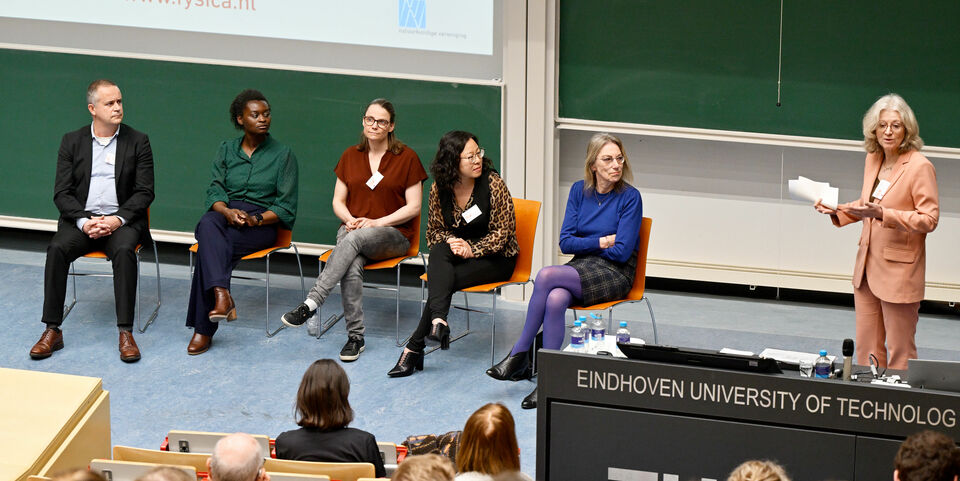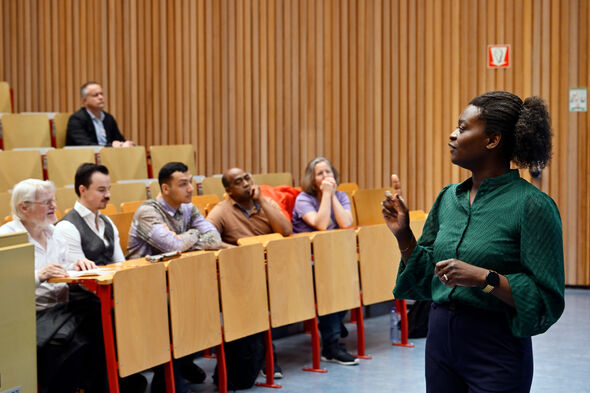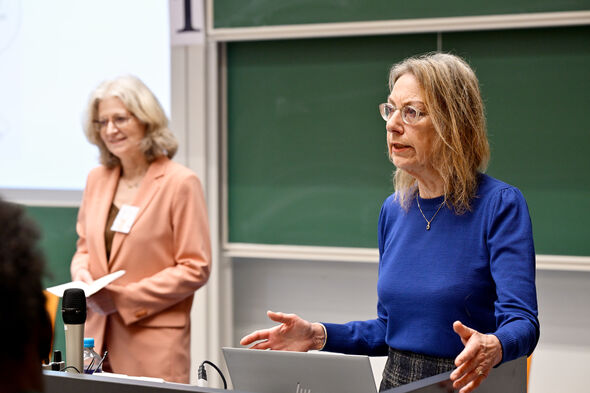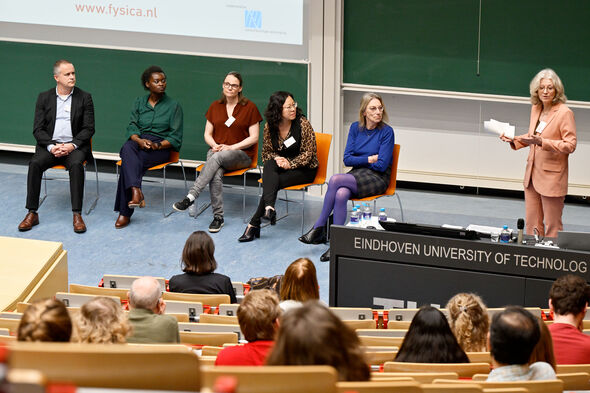Discussing social issues at Fysica 2024
Physics conference Fysica 2024 took place at TU/e on Friday, April 12. The theme was ‘Physics at a human scale’. Cursor attended the ‘Dimensions of Diversity’ focus session and the subsequent debate featuring the likes of physics dean Kees Storm. “The academic climate is a breeding ground for social unsafety,” asserts psychologist Iris Breetvelt.
In the afternoon, the Fysica visitors spread out across the Auditorium to attend their preferred focus session (seven to choose from). Originally, Susanne Täuber was scheduled to speak during Dimensions of Diversity, but she couldn’t make it due to private matters. Assistant Professor Rachel Plak (Leiden University) kicked off proceedings, sharing her knowledge of autism.
Highest number of autistic people
It’s particularly interesting to discuss this subject here, because Eindhoven has a much higher number of people with autism than other areas in the Netherlands. Research (Cambridge, 2011) shows this may be because we’re in an ‘IT-rich region’ (many jobs in technology and IT, ed.). The definitions of ASD and autism are both used in this Cambridge research. In her lecture today, UD Rachel Plak only spoke about autism and not about ASD, a term from the DSM.
Several schools from the Haarlem, Eindhoven and Utrecht regions participated in the Cambridge study. Based on the resulting information about 62,505 children, the prevalence of ASS was estimated to be 229 per 10,000 in the Eindhoven region. This was significantly higher than in the Haarlem (84 per 10,000) and Utrecht city (57 per 10,000) regions. Conversely, the prevalence of the two control conditions, ADHD and dyspraxia, was the same for the three regions. The researchers do point out a follow-up study is needed to clarify whether there are other reasons that may be able to explain the big differences between Eindhoven and the other cities.
“When you talk about autism, do you say ‘a person with autism’ (person first) or ‘an autistic person’ (identity first)?” Plak asks at the start of her lecture. It’s a debate that people still want to weigh in on, and that leads to differing opinions even within the community itself. Which is okay. Plak: “Ask the person concerned. What do they prefer?” That’s a common thread for her anyway: “Take the trouble of actually talking to people with autism. That’s also how we conduct our research, together with them. And for the rest, switch between the two options when you’re speaking in general.”
Genes and the environment
Researchers aren’t entirely sure how autism comes about. There’s a genetic component and an environmental component. But the ratio between the two and what’s the decisive factor in getting it or not getting it isn’t clear yet. One thing they do see is that children with autistic parents are more likely to have autism themselves.
Different support
Plak indicates we should embrace neurodiversity more. “Every person is different, everyone is ‘wired’ differently. There’s not always a label needed, it’s also an option to see this as human variation.”
There is a lot of research into experiences of autistic children in the school system. Children in primary school may be affected by stress, overstimulation and lack of social connection, which may lead to absenteeism. Conversely, very few differences are observed in academic performance between young people with or without autism in higher education. “What is noticeable is that students with autism are generally more inclined to focus on the studying itself rather than on student life, and sometimes don’t show up at exams because they’re worried they won’t do a perfect job. These students simply need slightly different support than their non-autistic fellow students.”
So what to do when you have a fellow student with autism or a PhD candidate with autism that you’re supervising and you’re wondering what you can do to give them the proper support? “Don’t make all kinds of assumptions, but ask what the person in question needs,” Plak reiterates. “People are sometimes worried about overstimulating them, for example by wanting to regulate the light at the workplace, but that’s not something every autistic person struggles with. If you know someone has autism, that doesn’t mean you know them.”
Social unsafety
In her lecture, psychologist Iris Breetvelt (University of Amsterdam Amsterdam) added social safety as a point of concern next to neurodiversity. “Social safety is the standard, but I’m sad to say that social unsafety is often the way things are in practice.” The room is quiet. “Sexual intimidation often makes the news and definitely occurs at universities, but scientific sabotage is often more detrimental to someone’s career in academia. What’s more, the academic climate in general is a breeding ground for social unsafety,” Breetvelt asserts.
“The workload is high, it’s very competitive, and there’s job insecurity and a lack of faith and trust in employees. There are very few winners and a great many losers,” Breetvelt says.
Psychopath behavior
“Women are currently very much underrepresented in physics. We do see that for the first time in history, they’ve outperformed boys in the natural sciences (PISA, 2018). But if we want more girls to end up in physics, we’ll also have to do something about the problems they experience, such as micro-aggression, sexist jokes, and being sexually objectified.”
Looking at leaders in academia, Breetvelt sees a lot of psychopath behavior. “This includes people deliberately telling lies about a colleague to damage their reputation. And as an individual, it’s difficult to do something about this if that same leader also has the power to change the rules. But employers are responsible for providing a socially safe environment.”
Leaders should lead by example
The two lectures are followed by a panel discussion on some statements relating to social safety and neurodiversity. Associate Professor Shuxia Tao, master’s student Marieke Mulders and dean Kees Storm take part, as do the two speakers.
When asked whether people in power should lead by example when it comes to diversity and inclusion, Storm answers in the affirmative. “They have a greater responsibility. But what exactly is power? When do you have it? The power to decide something? Or are you powerful when you have a proven track record in your field? Or the power to influence something?” His questions are considered rhetorical.
In response to the question of what needs to be done if leaders don’t change (or want to change), Breetvelt points “to the judiciary as a last resort. We also have the labor inspectorate, for instance, but they are hardly ever called in (for cased like these, ed.).”
The world is still designed for neurotypical people. Should we be more inclusive and, if so, what would that look like? The audience thinks that accessibility in particular shouldn’t be forgotten for people with a disability. But the majority of the room also wants to provide better support to other minorities. Plak: “To be more inclusive, you maybe need to give up some of your comfort as the majority. That’s why it’s easier to sustain the standard. But it does help to see good examples. This makes people realize that the step towards inclusion isn’t necessarily that big.”





Discussion